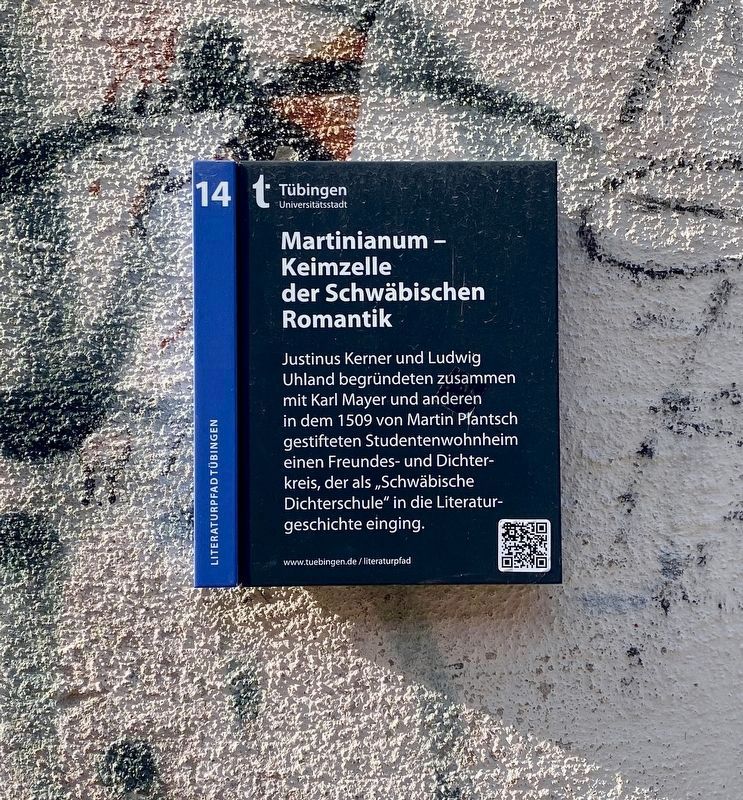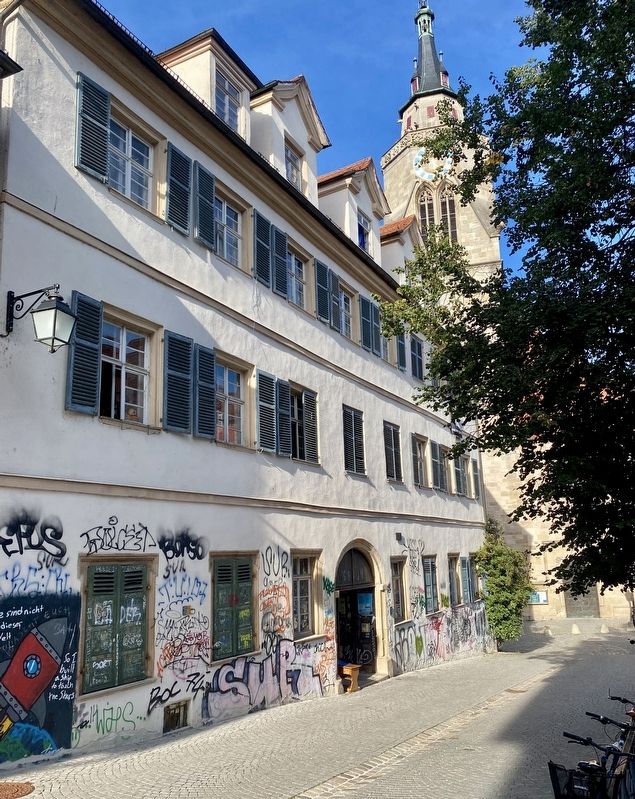Tübingen, Baden-Württemberg, Germany — Central Europe
Martinianum: Keimzelle der Schwäbischen Romantik / Nucleus of Swabian Romanticism
— Literaturpfad Tübingen —
Inscription.
Justinus Kerner und Ludwig Uhland begründeten zusammen mit Karl Mayer und anderen in dem 1509 von Martin Plantsch gestifteten Studentenwohnheim einen Freundes- und Dichter- kreis, der als „Schwäbische Dichterschule” in die Literaturgeschichte einging.
Justinus Kerner and Ludwig Uhland, together with Karl Mayer and others, founded a circle of friends and poets in the student residence (founded in 1509 with the support of Martin Plantsch as patron) that became known in literary history as the "Swabian Poets School".
Erected by Universitätsstadt Tübingen. (Marker Number 14.)
Topics. This historical marker is listed in these topic lists: Arts, Letters, Music • Education.
Location. 48° 31.197′ N, 9° 3.326′ E. Marker is in Tübingen, Baden-Württemberg. Marker is on Münzgasse, on the right when traveling west. Touch for map. Marker is at or near this postal address: Münzgasse 22, Tübingen BW 72070, Germany. Touch for directions.
Other nearby markers. At least 8 other markers are within walking distance of this marker. Polizei und Verfolgung unter Nationalsozialismus / Police and Persecution under National Socialism (a few steps from this marker); Alte Aula (within shouting distance of this marker); Former Dominican Building (within shouting distance of this marker); Philipp Melanchthon (within shouting distance of this marker); Nikodemus Frischlin (within shouting distance of this marker); Josef Eberle (Sebastian Blau) (within shouting distance of this marker); Hermann Hesse (within shouting distance of this marker); Tübingen Roma and Sinti Memorial (within shouting distance of this marker). Touch for a list and map of all markers in Tübingen.
Also see . . .
1. German Romanticism (Marxists.org). A short piece of literary history taken from the Great Soviet Encyclopedia, circa 1939. Although it may not be of the style of literary criticism that Americans might be used to, it does get to the point.
Excerpt: "The so-called “Swabian school” of Romantics was a group of minor poets-lyricists of Southern Germany devoted to provincial interests, local life and local landscape. Their lyrics usually had a folkloric tinge, and portrayed feudal patriarchy in positive tones. Typical poets of the school were Justinus Kerner (1786-1862) and Gustav Schwab (1792-1850). The creativity of the leader of the “Swabians,” Ludwig Uhland (1787-1862), the author of the famous ballads and romances, suffered to a lesser extent from patriarchal narrow-mindedness, which his students elevated to a principle. The Swabian school gravitated towards the political liberalism of the 1830s...."(Submitted on October 12, 2022.)
2. Schwäbische Dichterschule (Wikipedia, in German).
Excerpts (in translation): The summary - "The Swabian School of Poets was a relatively loose association of poets that had formed around Justinus Kerner and Ludwig Uhland at the University of Tübingen in 1805-1808."(Submitted on October 12, 2022.)
and on the School's role in the long-running debate concerning Romanticism's role in German society - "The conflict between progressive literature, which reflects and shapes the political and social discourse of its time, and conservative poetry, which stages an almost unchangeable landscape as a social counter-program, was formative for subsequent debates in German literature. While the protests of the early naturalistic authors were initially directed against the implementation of capitalist marketing strategies, bourgeois taste tendencies and moral concepts, conservative forces after the founding crisis again relied on the imagination of quiet, mostly fairytale, mystical and partly pagan landscapes for the purpose of transcending social conflicts."
Credits. This page was last revised on October 12, 2022. It was originally submitted on October 12, 2022, by Andrew Ruppenstein of Lamorinda, California. This page has been viewed 61 times since then and 5 times this year. Photos: 1, 2. submitted on October 12, 2022, by Andrew Ruppenstein of Lamorinda, California.

